In every mobile phone has a small internal antenna Sometimes she protruding from the body "cell phone" with a small pin or "growth". In most cases regular antenna provides reliable communication. But there are times when from your phone you need to squeeze everything possible. After all, even in the service area almost every base station has areas with unguaranteed coating, ie "dead zones" where the loss or restoration of communication is enough to make 2-3 step to the side. To ensure high-quality communications in such places, internal the antenna could use the help: additional removable antenna.
We can distinguish several cases when it is advisable to use additional external antennas:
- the conversation is shielded from the premises or the vehicle. Made outside antenna significantly improves the quality of communication. However, the presence of the cable between antenna and telephone and additional connectors leads to some loss of signal;
- between talking on the phone and the base station are massive structures, the terrain or thick walls, and the signal is weakened;
- the conversation is far from the base station (on the edge or outside the coverage area).
Additional antenna are especially necessary for phone in the car, as the metal body is the screen, obstructing the path of the radio signal. Taking a strong enough signal, the apparatus receives from the base station the command to increase power output, thus increasing the level radiation and increases power consumption. In addition, inside the car radiation from its antenna is reflected many times, as a result what all passengers are seated like inside a closed loop with internal radiation, as products in a microwave oven. Another point needs attention: the radio signal emitted by the phone, can affect the work some electronic devices of the car.
External car antenna not only helps to avoid the above of trouble, but also improves the quality of communication. This is achieved mainly due to the removal of the signal outside of the vehicle and more effective the redistribution of the antenna. How to correctly position the car antenna?
There is a rule that vertical (whip) antenna must be placed above the perhaps a greater metal surface. From this point of view, the middle of the roof car is the best place to install a vertical antenna. In addition to the roof, for installation of the antenna is also good for the back or front fenders. But metal bumper is far from ideal.
Among the large variety of designs deserve the attention of so-called "mortise whip antennas". Their main advantage is the direct contact with the body ("mass") of the vehicle, positively affecting workers the characteristics and, in the end, the quality of communication. To install mortise antenna it is necessary to drill the roof of the car, well insulated against moisture place the installation of the antenna and carefully fasten the connection cable so that it does not pounded inside the hull.
Antenna with magnetic base (Fig.1) at the expense of adaptability and simplicity installation is extremely popular among car enthusiasts. Still, if necessary this antenna is easy to clean in the cabin, and the magnet will not let her fall even high speeds. But for convenience, must be something to pay, and payment - a few the worst performance.
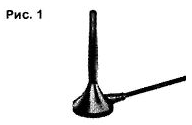
When you select the "magnetic" antenna should be taken into account that the change in cable length and installing it without a rubber gasket between the magnet and the body negatively affect the operating characteristics of the antenna.
There are "dvukhkomponentnye" antenna, consisting of two parts. The base part with the cable leading to the phone mounted on the windshield inside the passenger compartment, and the other part - outside, in front of her. Between them is provided by capacitive coupling. Unfortunately, it's not the most efficient way of transmitting the signal, after passing through the glass, he waning. In addition, unwanted installation of this antenna near a variety metal coatings, for example, tinting or heater strips on the glass.
The market is also present adhesive antenna. They are made in the form of a tape or small boxes (Fig.2) and glued to the inside of the glass.
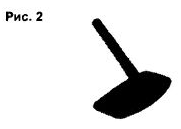
The cable is usually supplied with the antenna, as connecting to wow the antenna is one-piece. The original length of the cable is usually 3 m. If the installation of the antenna it is cut, it is necessary to install the connector on the end. This operation must be done very carefully. Improperly installed connector or poor contact in it can disrupt the entire system.
Many models of cell phones has a connector for an external antenna. Then the cable connects to it. When you enable the connector to the phone antenna the path is automatically switched to the external antenna. In case of difficulties "ripping off" the right connectors, you can use a commercially available antenna adapter. They are short piece of cable with one sides - high-frequency telephone connector and standard cable high frequency connector (Fig.3). Typically, the attenuation in the antenna the adapter does not exceed 1 dB.
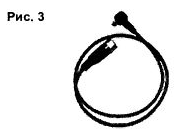
Some phone models do not have a special socket for a replacement antenna. Their you can connect through the speakerphone. The cable from the antenna joins Tommy device connection, and the phone is inserted into the socket of this in the device. In principle, it is possible to detach the regular antenna and connect phone the external antenna cable instead. but this. of course, it is inconvenient.
When communication with stationary objects (apartments, offices, cottages) in the case uncertain reception, it is advisable to use an external directional antennas. Of course, the phone becomes less mobile, as connected to antenna cable, but the quality of communication in many cases is very good. Basic forms of directional antennas are antennas "wave channel" and automatic process. The most popular first. They have high gain and easy to manufacture. Automatic process of the antenna is more complex and expensive, however have a large bandwidth and do not require additional configuration.
Antenna "wave channel" (Fig.4) is similar to the eponymous television antenna. She consists of a series of elements arranged in one plane: half-wave (linear or loop) active vibrator that is connected to the cable reduce, reflector and Directors (passive vibrators). The length of the reflector and its the distance to the active vibrator is chosen so that the reflector weakens the radiation of the active vibrator in the opposite direction and increases in direct, i.e. the reflector is a kind of reflector that provides the formation of the unidirectional characteristics of radiation (reception). Often in the reflector system is used vibrators or mesh. Strengthening radiation in the forward direction contribute to the Directors, which are excited, as and the reflector, under the influence of radiation of the active vibrator.
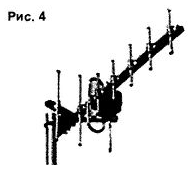
The advantages of the antenna wave channel can be attributed to the relatively high the gain at the simplicity of design, the disadvantages - difficulty settings when the number of Directors of more than three. Antenna, even collected one drawing, are configured differently. The real gain of this antenna is obtained as the rule specified below (on average 3...4 dB). In addition, a narrow strip bandwidth leads to a dramatic decrease in the gain in those communication systems use duplex frequency with a large variability. For example, a standard DAMPS uses frequency 824...840 MHz and 869.. 894 MHz, so the use of the antenna "wave channel" that is configured in the middle of this range, leads to a noticeable the deterioration of the antenna on the edges of the range (i.e. at the operating frequencies). The same applies to popular standards GSM-900, GSM-1800. The program for calculation antenna "wave channel" can be found on the website www.3ton.com/gsm.
Automatic process of the antenna is one of the types of antennas with the same form chart orientation and a permanent boost in a wide range of frequencies. Automatic process antenna formed collectively by a line in the form of two tubes, arranged in parallel, which in turn (one) mounted vibrators. Such antennas in the frequency range provides a good agreement with the feeder. Bandwidth "bottom" depends on the size of the longest vibrators and "from above" - from the size of the shortest. Antenna gain is determined by the number of vibrators, each of which is active. Therefore, by setting the bandwidth (the maximum and minimum sizes vibrators), it is possible to obtain a sufficiently high gain in all the range by increasing the number of vibrators. Automatic process antennas work well in broadband communication systems, but have a more complex design compared with antennas "wave channel".
Stationary antenna is mounted on the bracket or mast and sent to the base station, the signal which is stable. "Base" is not must be the closest, as all depends on the location of the antenna and the topography of the area. It is possible for the base with the strongest signal level "don't wants" to work with the phone, as it is located at a distance which more of the theoretical maximum range for standard mode (35 km GSM-900).
The orientation of the antenna needs to be done carefully, slowly rotating antenna" the horizon and watching the signal strength indicator on the display of the mobile phone or using engineering Netmonitor menu (for devices "Nokia"). In most other phones, you can enter a special code to access the service a menu that allows you to see the level 6...8 frequencies taken by phone descending order of channel number, distance to the base station, the error rate in the channel, etc. descriptions of many service menu are available on the website www.3ton.com/gsm.
If Netmonitor is, to better focus on the signal level in decibels (the signal is stronger when the level value in decibels less) If he is absent, setting is carried out on the standard scale signal. Since the change of tension the fields displayed on the display immediately, but after 5... 10 C, to change the position the antenna has to be based on this time so as not to slip direction on the strong signal. In the menu of the cell phone you need to enable Continuous search network.
For example, the range of GSM-900 contains 124 of the channel with a step of 0.2 MHz and the spacing between the frequencies of transmission and reception of 45 MHz. For mobile phone reception frequency start with 890 MHz and transmission - 935 MHz. The average frequency of the mid band is $ 922.5 MHz (a quarter wavelength is 81.3 mm). To increase the effectiveness of the external antenna is recommended for its manufacturing setup in as the operating frequency not take the average between the frequencies of the receive (Rx) and transmit (TX), and the frequency of transmission (TX) as the maximum power of the transmitter mobile phone, of course, less than that of the base station, and at worst conditions, the phone will simply not be heard.
From the length and quality of the connecting cable depends on the gain of the entire the antenna system connected to a cellular phone. Passport data of the external antennas do not take into account the length of the cable (this also applies to car antennas with circular directional diagram). If no external antenna can at least sometimes to hold a conversation, then you can do a directional antenna with gain 9 11 dB.. cable lengths of up to 10 m. If installing the antenna in a convenient location requires 15...20 m cable, then you need or take it with better quality or to use the antenna with gain 13... 16dB, which is usually cheaper.
Domestic television coaxial cables can only be used limited (the attenuation is more than 30 dB at 100 m - too large). Available import samples suitable RG6 coaxial cable with double braid (attenuation is 20. .24 dB per 100 m). Industrial road whip antenna is normally equipped with cable RG59 (attenuation 28 dB at 100 m). Antenna "wave channel" gain 12 dB and 10-meter cable RG6U give a total gain of about 10 dB, and when the 20-meter cable - 7 dB.
When the communication quality is at a "critical" level, even simple whip the antenna, but raised higher, can improve the situation. Depot including. when talking on a cell phone about 10...20% of the energy is absorbed by the body subscriber, so when you lift the antenna up decreases the impact on her surrounding objects.
Well, the simplest dipole antenna can be made literally Take 15 min. white TV RG6U cable, cut one end of the upper isolation and "chop it. Receive the center conductor and the braid of the cable To the center conductor solder copper wire with a diameter of 1 to 2.5 mm and a length of 82 mm (for the 900 MHz band). To braid the second solder a piece of wire like this same length (Fig.5).
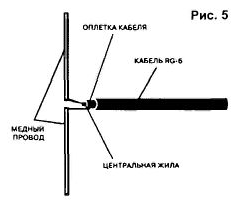
The other end of the cable connected to the phone (via a connector or the adapter). Have *Rog" vertically (one up, the other down), and get something similar to the letter "T", put to one side (in GSM is used in vertical polarization, so it is the location of the dipole) At the manufacture should be careful not to connect the Central conductor braided, otherwise the phone can burn.
Sources of information
Author: A. Kashkarov, St.-Petersburg






